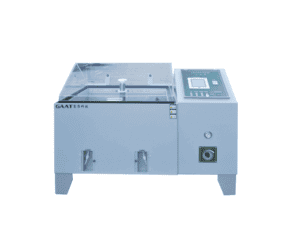1. Understanding Reliabity
Definition of Reliability
Reliability is the ability of a product to perform its specified functions within a specified period. It reflects the probability of a product failing under various usage conditions and encompasses multiple requirements, including basic performance, safety, and failure rates.
General Overview
Reliability testing involves artificial simulation and accelerated aging tests to verify a product’s reliability under specific conditions. These tests ensure the product’s longevity and performance consistency.
2. What is Salt Spray Testing?
Salt spray corrosion is a prevalent and destructive form of atmospheric corrosion. The salt spray test is an environmental test that uses specialized equipment to simulate salt spray conditions, assessing the corrosion resistance of products or metal materials.
Applicable Range
- Metals and electroplated materials
- Electronic products
Test Purpose
The test verifies the resistance of metals or protective materials to salt spray corrosion, ensuring their durability in harsh environments.
Test Principle
When salt spray lands on a sample’s surface, it corrodes the metal and its coatings, increases the conductivity of insulating materials, and accelerates their aging. This test uses a chamber to simulate a high-concentration salt spray environment, significantly accelerating the corrosion process compared to natural conditions.
3. Categories of Salt Spray Tests
- Neutral Salt Spray Test (NSS Test)
The most commonly used method, employing a 5% sodium chloride solution with a neutral pH (6.5-7.2). The test is conducted at 35°C, with a salt spray deposition rate of 1-2 ml/80cm² per hour. - Acetic Acid Salt Spray Test (ASS Test)
An enhancement of the NSS test, adding acetic acid to the sodium chloride solution, reducing the pH to 3.1-3.3 and making the solution acidic. - Copper Accelerated Acetic Acid Salt Spray Test (CASS Test)
A rapid corrosion test conducted at 50°C, adding copper chloride to the salt solution to induce strong corrosion. - Cyclic Salt Spray Test
Combines the NSS test with a constant humidity and heat test, mainly for complete products with cavities, alternating between salt spray and humid heat environments to assess electrical and mechanical performance changes.
4. Common Reference Standards
- GB/T 10125, ISO 9227: Artificial Atmosphere Corrosion Test – Salt Spray Corrosion.
- ASTM B117: Standard Practice for Operating Salt Spray (Fog) Apparatus.
- GB/T 2423.17, IEC 60068-2-11: Environmental Testing – Part 2: Tests – Test Ka: Salt Mist.
- GB/T 2423.18, IEC 60068-2-52: Environmental Testing – Part 2: Tests – Test Kb: Salt Mist, Cyclic (Sodium Chloride Solution).
5. Application Fields of Salt Spray Tests
- Road and Transportation
Includes electronic and electrical equipment for road and railway vehicles, automotive parts, etc. - Computers
Covers computers, monitors, mainframes, computer components, and precision instruments like medical devices. - Electronic Communication
Involves mobile phones, RF devices, electronic communication components, PCBs, and PCBAs. - Appliances
Pertains to home appliances, lighting, transformers, various household electrical equipment, instruments, and medical devices. - Others
Includes electroplating, coatings, packaging boxes, and transport equipment.
6. Products Subjected to Salt Spray Tests
Typically, products or components exposed to salt spray or at risk of corrosion undergo these tests. This includes metals and alloys, metal coatings like tin and nickel plating, and organic coatings like spray paint and anodized molds. Some products may require complete machine salt spray tests.
7. Salt Spray Test Chamber
Salt spray tests are conducted using a test chamber that employs compressed air to produce a spray, thoroughly covering the sample surfaces. Tests can be continuous or cyclic until desired corrosion phenomena are observed, and the time of corrosion occurrence is recorded to evaluate the sample’s corrosion resistance.
GAAT can supply different type of salt spray chambers to meet the international testing standards.
8. Result Determination
Test Duration
Defined by product specifications, ranging from 2 to 148 hours. For general civilian products, 72-96 hours is typically sufficient.
Factors Affecting Results
Various factors can influence the test results, making the actual situation complex.
Common Corrosion Evaluation Methods
- Calculating the corrosion area and rating according to relevant standards (e.g., GB/T 6461)
- Appearance description including rust presence, rust type, corrosion extent, bubbles, or cracks
- Functional checks for finished products
- Other metrics such as adhesion, pencil hardness, and corrosion width
This comprehensive guide to salt spray testing standards and procedures helps ensure that products maintain their integrity and performance in corrosive environments.
Feel free to contact us if you have an inquiry about the salt spray test machine.



